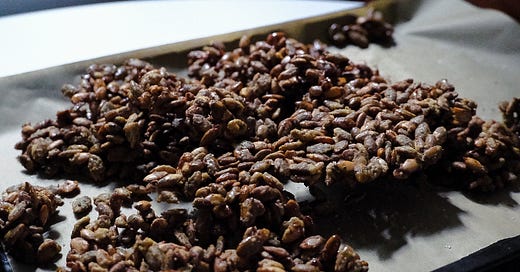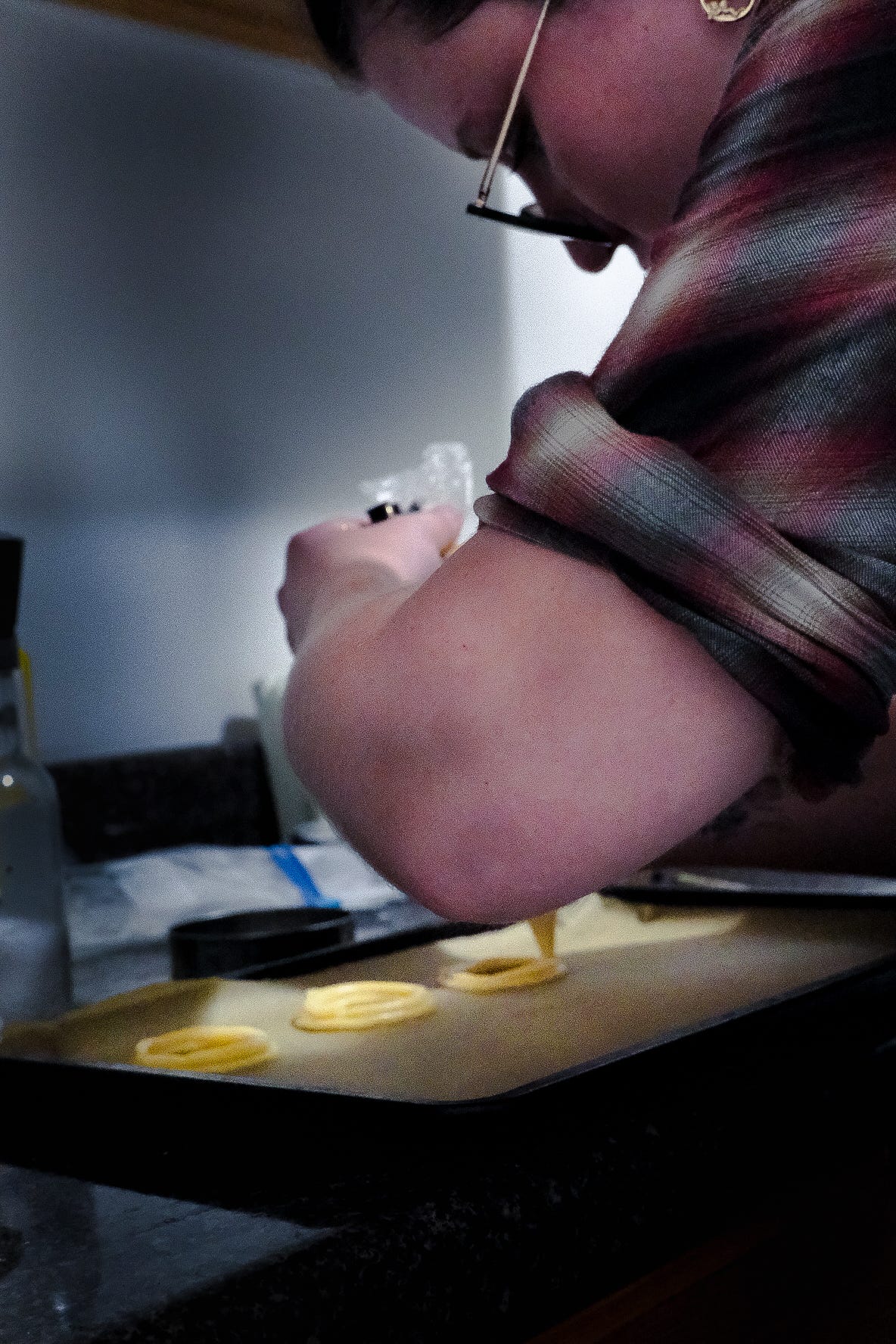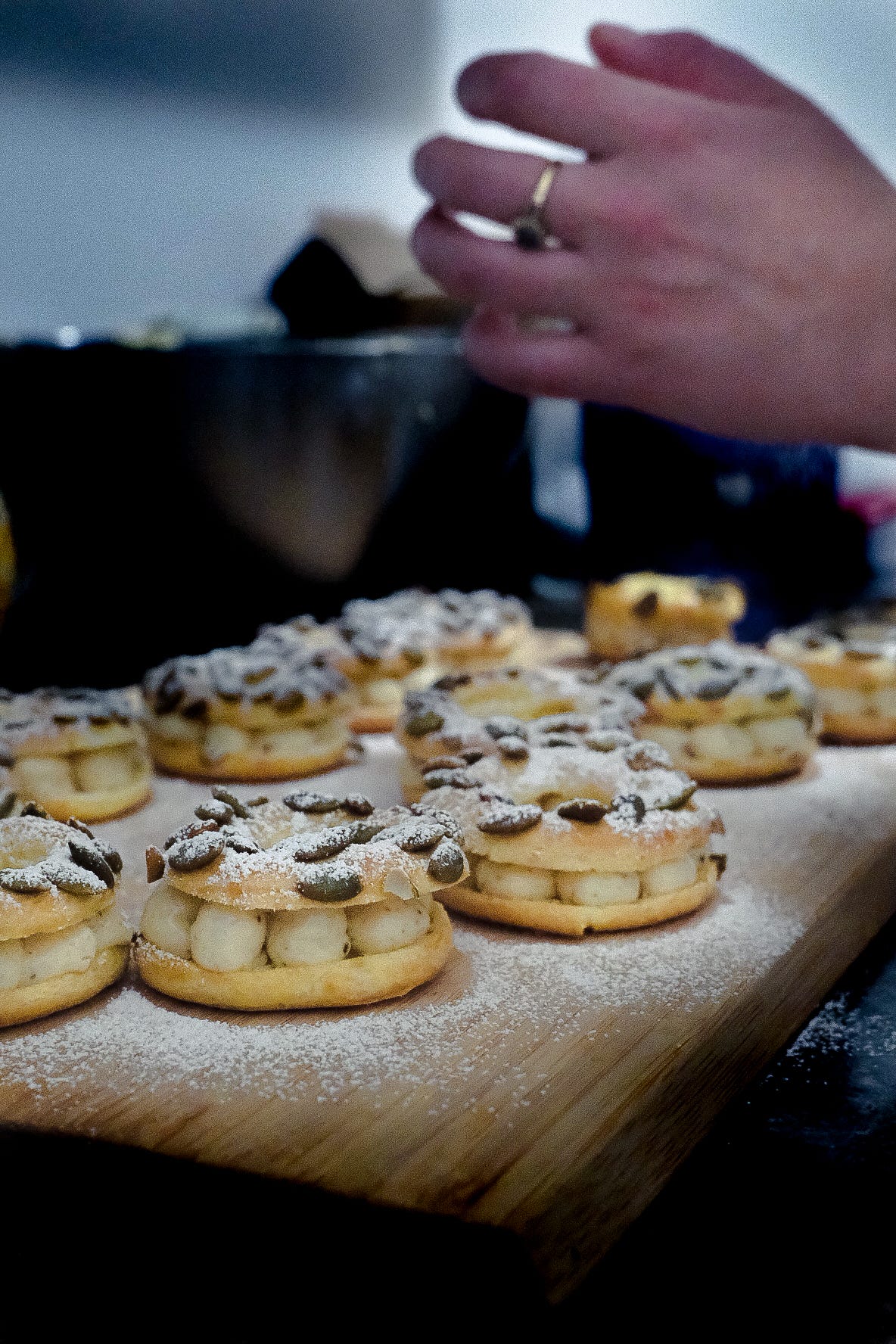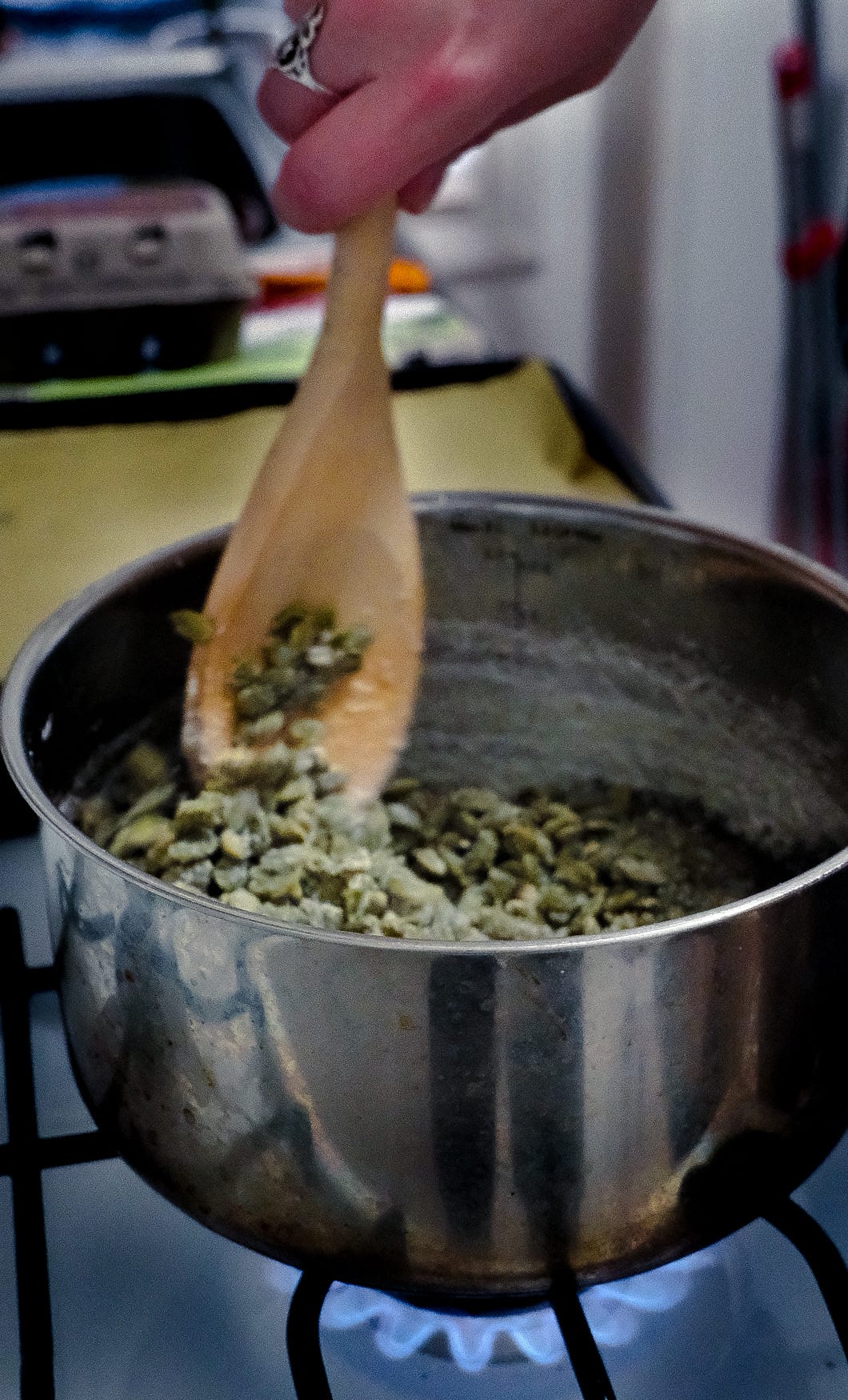Pepita Praliné with Pastry Chef Diana Dover - No. 10
And if you're new in the kitchen, you'll love "questions from our friend Ailis."
Welcome to Vegarie. If you found your way to my substack and don’t know me intimately, I’m confused. How did you get here? Help me with my confusion by tapping below to subscribe (for free!) and receive my newsletter biweekly on Tuesdays. Included are interesting stories about women who cook and their tips on becoming more creative in the kitchen. Additionally, I share recipes for dips, spreads, and condiments.
This week I’m especially thrilled to be joined by Pastry Chef Diana Dover. She is incredibly knowledgeable in the world of French patisserie, fine dining…and adlibbing Ariana Grande Christmas songs. Aside from her musical parodies and slapping Lady Gaga’s little sister in middle school—which are both impressive feats—Diana has an extensive resume in the culinary industry. Having worked alongside celebrity chefs like Keith McNally and Daniel Boulud, it’s safe to say she provides incredible insight and technical skills. She's the type to casually make a cheese soufflé on a Monday night and explain all kinds of complex French techniques with a certain ease and non-pretentiousness which make them sound approachable. Above all, however, Diana impresses me most with her creativity and the way she glows when she talks about food that she loves. Together, we make a pepita praliné, talk about some of the amazing desserts she prepared at volume, and her first experiences within the world of fine dining. On top of that, she’ll pass along some tips on whipping up delicious ice cream at home, and of course, bless us with her bagel order. You’re going to love this one.
A native New Yorker, Diana grew up with exposure to a wide range of cuisine, most of which I’m sure we didn’t even know existed until our twenties. Outside of once-weekly family dinners with her parents, who often worked late into the night, Diana spent much of her childhood eating quick and easy meals she could prepare on her own. Think Kraft mac and cheese, spaghetti with butter, and frozen chicken nuggets. She still finds comfort in her old neighborhood haunts. Lenny’s Bagels on W 98th & Broadway and Absolute Bagels, also along Broadway uptown. Aside from being “reliably fresh, chewy, and standard” bagels, she has dubbed these her favorite spots due to nostalgia. These bagel shops are “exactly like they were when [she] was a kid, with those same fossilized, barbeque sauce slathered turkey burgers sitting at the deli counter. The kind you never order and are not sure who does. The ones you’re sure are the same burgers from the very first visit.” What does this New York native order you ask? Well, Diana’s classic bagel order is an everything bagel with scallion cream cheese, not toasted, because “every quality bagel should be spared the violence of a toaster.” Sometimes she will add bacon, “if I’m feeling frisky.”
Her kitchen exploration began in the sixth grade when she decided to become a vegetarian. From there, she learned techniques by watching Food Network, reading baking blogs, and zines. Before long, baking became her biggest hobby.
“I remember one of my first big baking projects being these lemon meringue cupcakes. I was 12 and my mom let me buy a mini blow torch that I found at TJ Maxx to finish the meringue.”
Now, I don’t know about you—but I don’t know a lot of 12-year-olds that could handle a blow torch, even if it's mini. Those and her chocolate chai cupcakes were the first fancy pastry feats she remembers feeling proud of. Alas, her cupcake obsession didn't last much past middle school. Not really having a favorite dessert, Diana “loves to constantly learn new techniques,” and tends toward making ice cream at home. This has been a favorite of hers even before entering a professional environment, and she recommends making yours at home with a simple cream custard and a little toasted cinnamon.
"I once did my custard with half sweetened condensed milk, half whole milk, toasted cinnamon, and cinnamon sticks--plenty of cinnamon, it was delicious. In general, to make ice cream you just need your dairy--milk and cream--the ratios for which will be different depending on your recipe, and then sugar and eggs. The amount of egg yolks vary as well depending on how rich and creamy you want your ice cream to be. The more yolks you include, the creamier and richer the ice cream will be. While warming your cream mixture you can infuse the flavors you want, like with a flavored syrup or even fresh herbs or citrus. Then temper it into the egg mixture and pour it into whatever ice cream maker you have. You don't need anything fancy. The standard Cuisinart one that I have was probably $60 and does a great job."
Having friends within the fine dining industry, Diana's first kitchen job was at Cherche Midi, a classic French bistro—now closed—but owned and operated by Keith McNally. Keith McNally is a British-born hospitality guru and the man behind Balthazar, one of the city’s finest all-day brasseries. When she first started, she thought she wanted to be on the savory side, feeling that she already knew how to bake. “Little did I know, there was so much more to learn. Especially as it stood in French patisserie.” She remembers being faced with her first task in a restaurant setting, “peeling this giant tub of roasted red peppers and thinking, oh my god, what am I doing here? I was overwhelmed by being in a restaurant kitchen for the first time…plus there was a lot of char on those red peppers.” Shortly after the red pepper fiasco, she was passed along to trail with the pastry chef instead and she confirmed that this was where she belonged.
“It just made more sense to me. The pastry chef was very trusting with my tasks considering I didn't have any experience. They allowed me to do a lot of the plating since it wasn’t very complex, and eventually, they asked me to prepare all the macaroons…I was like—What? Me?! But I made them bizarrely well on my first attempt—beginners’ luck—then had some foils with until I understood the method.”
The following summer, she reached out to the sous chef at Cherche Midi looking for another opportunity, and was connected with a position at Balthazar Bakery. "That was a simple job, mainly finishing tarts, scooping cookie dough, basic stuff." After finishing college—where she majored in French and planned, at the time, to teach English in France—she trailed for another summer job in pastry. After trailing at some prestigious spots: The Nomad, Café Boulud, and Jean-Georges, she ended up with a pastry internship at Café Boulud.
"I couldn't believe with the very limited experience I had that Michelin-starred restaurants would take me in for a trail. I was turned away immediately at Jean-Georges when the Pastry Chef took me into the walk-in and asked me if I wanted to be a Pastry Chef. When I said, I don't know exactly yet, he just told me plainly, "we don't have time for this. You would have better luck…anywhere else," basically. I remember leaving and feeling embarrassed, upset that I had been turned away so quickly and, on my walk home, actually got the email from Café Boulud which offered me an internship. And that's how I started working for Danny Boulud's restaurant group. The rest of my career came from moving upward through his company."
She did indeed spend a year in France teaching English, but upon returning to New York, went right back to pastry. Diana got her first full-time pastry gig working for Boulud Sud, an eclectic Mediterranean-inspired restaurant, featuring dishes that may be found anywhere between Southern France and Northern Africa. Next, Diana moved on to be the sous chef at DB Bistro, another Boulud French Bistro, this time across the street from Lincoln Center. A pre- and post-Broadway destination, this was her first experience working in more of a pre-service prep role and on a timeline of her own. Diana learned to be fast and efficient, the pressure on them to “produce desserts that looked absolutely beautiful, without even a little bit of smudge—because these desserts were at least $18 a plate.” One that she recalls in particular, was their flagship dessert called the grapefruit givre—a grapefruit sorbet served beautifully in an entire frozen grapefruit peel, like a cup, and topped with rose loukum and sesame halva. To produce this, she would have to scoop 120 grapefruit sorbets in an hour, every night, one hand frozen and numb holding the grapefruit shells, the other madly scooping and topping. Along with the numbness and inevitable carpal tunnel is the stress of watching time tick by knowing that, “the last thing chef wanted to do would be to ask the guests to return after their show to enjoy their dessert. This was even worse if the kitchen was behind on the preset meal, then we really had to push to keep up with tickets.”
Her tip for speed and consistency? “Use your eyes and your hands—it’s what my chef would always tell me. I took that to mean immediately deciding what your end goal is for the plate and getting the rhythm down for naturally placing it that way, repeat. You don’t have time to be a perfectionist and don’t have time to place a pistachio one at a time.” This being a personal struggle of mine, not being able to let go of perfectionism and move quickly, “this just comes with time and confidence,” she says.
Due to the COVID-19 pandemic, Diana was laid off from DB Bistro and after 6-months of unemployment, was called up to operate as a pastry chef at Daniel.
"At times it felt like I was set up for failure because we had so much on our prep lists, perfect puff-pastry twills, twisting them around a mold, baking them, and then unrolling it all without breaking—it just felt like there was no other way to speed these tasks up. I asked the other prep cooks if they ever felt like they had a good day here and they’d tell me no. I left that job without finishing my list.”
“…this has always been a terrible environment to work in, but it will make you a monster.”
Everyone has different working styles, but Diana felt that she was a lot more efficiently working on her timeline, with her prep list, instead of under pressure from scary chefs. I asked her was she thought about the recent shift in kitchen culture caused by the pandemic and people starting to speak out about unsustainable work environments. Think, for example, of the recent announcement from René Redzepi, known for being one of the worst “scary chefs,” closing three-Michelin-starred NOMA. We wondered, together, why environments like that produce such amazing performances, whether they can exist in different circumstances or if they go hand-in-hand.
“It is so deeply satisfying to create a perfectly choreographed experience, that’s really what fine dining is about. Since leaving, I’ve asked myself a lot if it’s the only environment where I can create the kind of food I’m excited about. If the pressure is part of what produces a high-quality result. I’m not sure what the answer is. What I do remember, just before leaving Daniel, was having a breakdown after an especially stressful day and exclaiming to one of the chefs, and myself, what am I doing here? I never wanted this for myself. And him just telling me, this has always been a terrible environment to work in, but it will make you a monster. The chefs there were so efficient, so perfect.”
This gives me a lot to think about Diana. I want to thank you so much for taking time out of your busy week to talk with me, bake with me, and share tips for myself and others who are just entering professional kitchens.
The last thing that I like to ask everyone that I highlight on Vegarie is, why is food so important to you, Diana, and why do you feel like food brings so many people together?
“Post-restaurant life, cooking still feels like my medium in a lot of ways. I just feel so comfy in the kitchen and I love to eat delicious things. Those two things are my greatest pleasure and bringing food to others is how I share that.”
Pepita Praliné
So, I know my readership pretty well, and I’m sure you’re wondering; what is praliné, exactly? Well, praliné is a thick paste made with caramelized nuts which are cooled down to room temperature, and then blended in a food processor to create a delicious, sweet, salty, and slightly crunchy paste. It’s like a love story between nut butter and cookie butter—they meet at a carnival, nut butter hangs from the Ferris wheel and swears he won’t let go until she goes on a date, cookie butter is reluctant, but when she finally goes on the date, she falls madly in love…wait I’m just describing The Notebook. Anyway, these two combined, make a praliné.
Ingredients
600g pepitas
400g sugar
130g water
Salt, to taste
Instructions
Preheat oven to 300F/150C.
Spread all 600g of pepitas on a sheet tray to toast, about 15 minutes or until lightly golden. Let cool back down to room temperature.
Combine sugar and water in a sauce pan. Bring both to medium heat (204F/116C) — checking with an electric thermometer. If you don’t have an electric thermometer, you can try watching for the mixture to rapidly bubble, and then to begin to slow down. This is usually a good indicator that it has reached temp.
Stir in your pepitas until fully coated. The sugar will naturally begin to crystallize on the outside, this is normal. Keep stirring on medium-low heat.
The sugar will eventually melt again on the outside of your pepitas and become caramel. To prevent burning and sticking to the pan, never stop stirring until the nuts have evenly coated.
Once caramel-coated, spread your pepitas back onto a silicone mat or parchment paper and allow to cool and harden.
Blend in food processor until you have created a smooth paste. This may take a while depending on the power of your food processor. Salt generously to taste throughout this process. (Note that you may add a bit of vegetable oil, or neutrally flavored oil to the mixture if the paste is becoming too dense. The end result should be smooth with crunchy bits of caramelized nut!)
Use it to make a fancy pastry, mix it into your buttercream, ice cream, or—my favorite—slather on a piece of toast and top with a little flaky salt.
Questions from our friend Ailis - Answered by Diana Dover
How do you know what’s too much salt and what’s not enough?
“You learn the touch, taste, and timing of salting something depending on what it is you’re making. If you’re seasoning pasta water, for example, you are looking for seawater. Salads, eggs, tomatoes, fruit, you’ll season lightly right before serving. If you’re cooking other things, just remember you can always season more but never season less, so start with less and taste.”
How do I cook my salmon all the way through and produce a crispy crust? I always end up with the inside being too raw when my skin is to the crispiness I like.
“As a pastry chef and not a savory chef, I have less experience cooking proteins—so I’m sure there are other ways to check the internal temperature—but in pastry we often use electronic thermometers. Since this is already a part of my tool chest, so to speak, I suggest investing in one when learning to cook new proteins. Become confident with the temperature you need to bring it to. And possibly turn down your oven temp. Low and slow can still provide a crispy skin.”
How do I stop myself from eating during the cooking process? I always start eating as I’m cooking and by the time my meal is finished, I’m not that hungry anymore.
“I have no experience with that. I would suggest hypnotherapy.”








